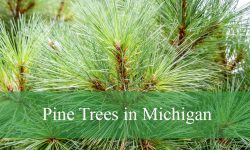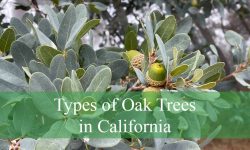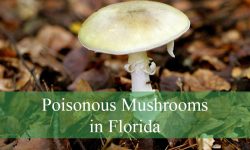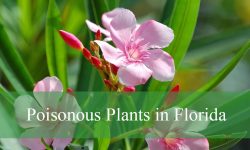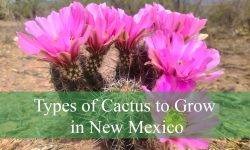With their fragile blooms that convey grace and purity, white wildflowers add an ethereal appeal to a variety of landscapes. These blooms capture with their ageless elegance, whether they are found in the sun-dappled meadows of the tropics or the snow-covered plains of the Arctic.
Whether nestled among verdant foliage or dancing in the gentle breeze, white wildflowers offer a serene and enchanting presence, enriching ecosystems and inspiring awe in nature enthusiasts worldwide.
Different Types of White Wildflowers
Morrow’s Honeysuckle
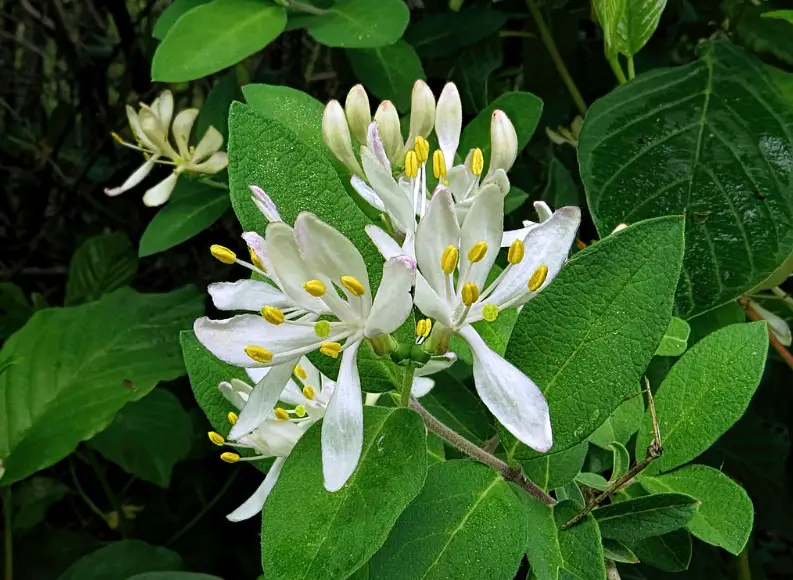
The very invasive species of honeysuckle known as Morrow’s Honeysuckle (Lonicera morrowii) can grow up to several feet in height and width. Its white or yellow flowers, originally introduced for decoration, increasingly crowd out native plants, as it thrives in disturbed regions and woodlands.
Oxeye Daisy
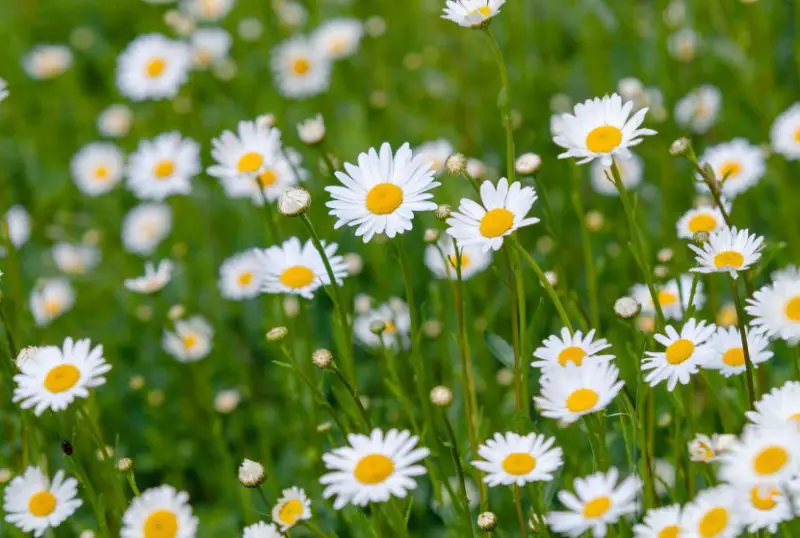
The unique North American import, the Oxeye Daisy (Leucanthemum vulgare), has yellow flowers surrounded by long white petals. Growing on sunny plains, its flower has a variable number of petals, usually about 14. Known to be invasive, removal without mechanical assistance is difficult because of its fast growth.
Late Boneset
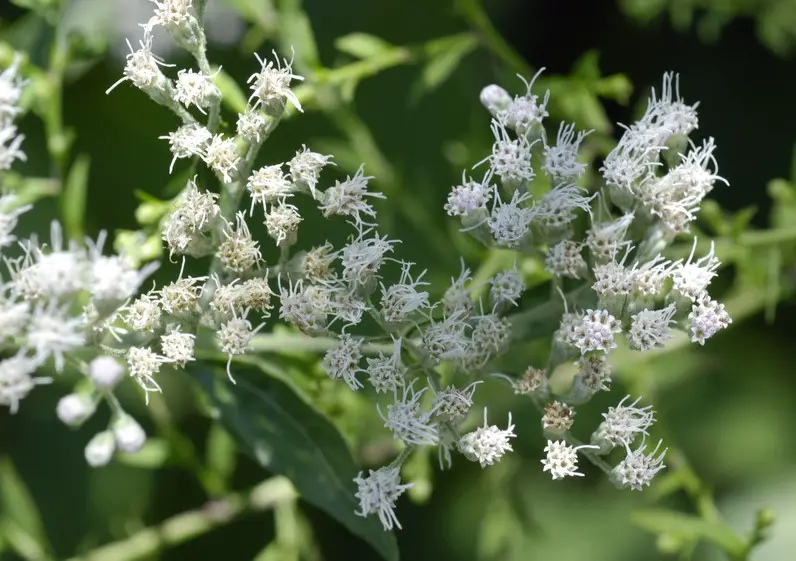
Eupatorium serotinum, or late boneeset, is a native of North America, which includes both the United States and Mexico. It is distinguished by an abundance of white flower heads, each ornamented with many small florets. Prefering plenty of soil moisture and some shade, this wildflower has up to fifteen distinct florets. Precise identification is difficult in crowded, wet environments, where it may hybridize with the closely related Common Boneset, which has similar white flower heads.
Rue Anemone
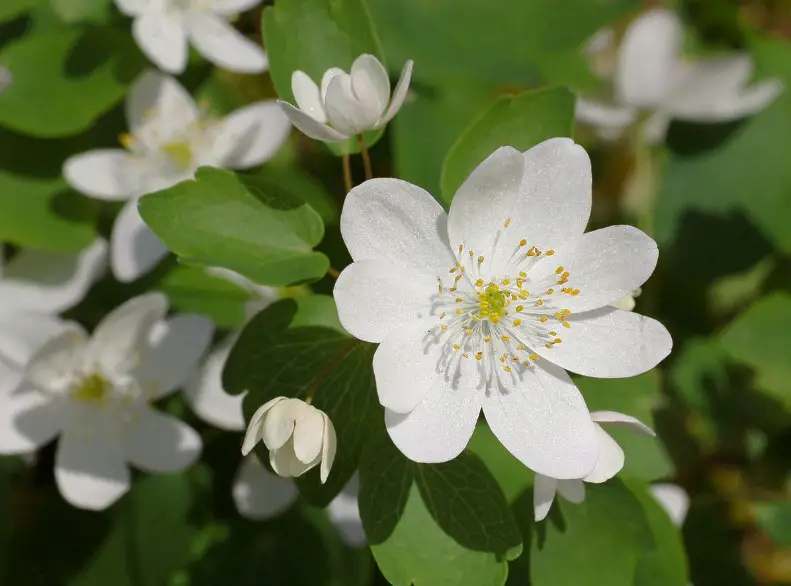
Among the springtime bloomers in North America is the rue anemone (Thalictrum thalictroides), which features white flowers with pink-edged petals. It thrives in clearings on the borders of mixed and deciduous forests. It can reach a maximum height of 12 inches and reliably yields up to 6 white flowers.
Chinese Privet
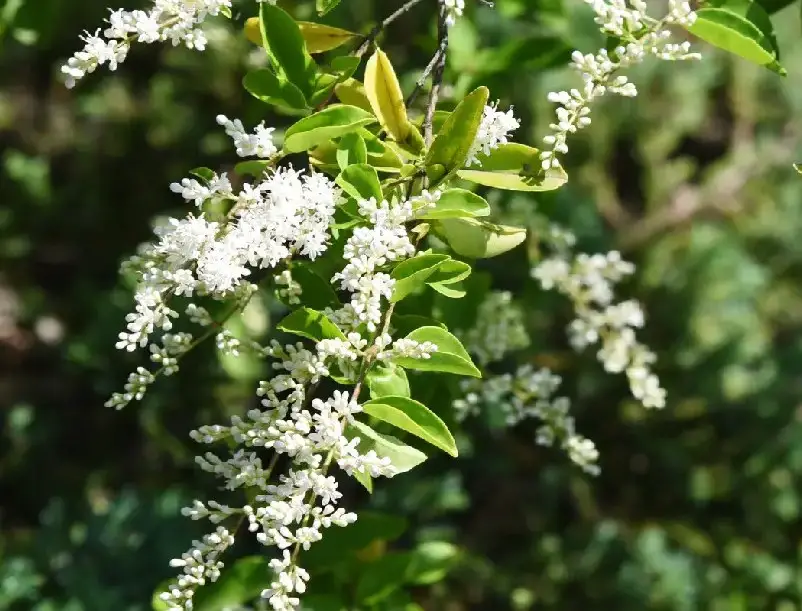
Originally prized for hedging, Chinese privet (Ligustrum sinense) is an infamous invasive species in North America. Native plants are displaced by its rapid growth. Known for its white blooms and dark blue fruits, this plant spreads along the roadsides and woodlands of the Eastern United States before moving on to Central America.
White Avens
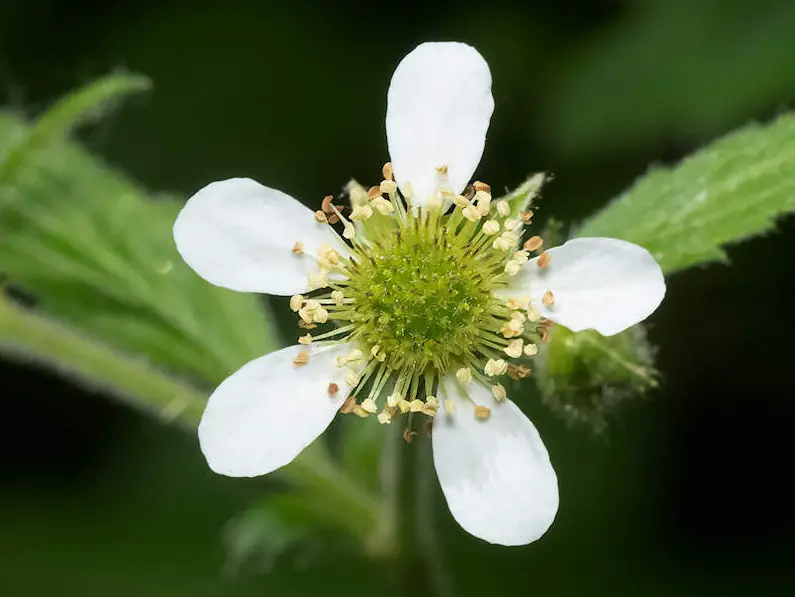
The White Avens (Geum canadense) have five green sepals and unique white petals that resemble other rose-family flowers but with petals that are spread apart. Its adaptable character makes it thrive in a variety of conditions, including partial sun and different soil types like loam. Still, given its rapid growth, it could present problems similar to weed control in gardens.
Large White Trillium
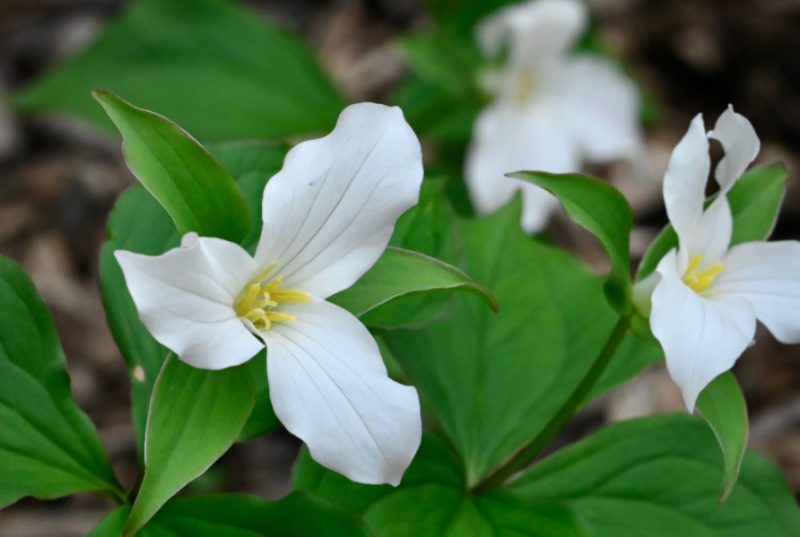
Native to North America, the Large White Trillium (Trillium grandiflorum) grows well in a variety of environments, though it especially likes lush woodlands. Adapted to forests, it has three large, widely separated petals that are usually white but can occasionally be pink. Though primarily white, Virginia is the only state with the pink variety. The pink and white varieties both grow to a height of around 20 inches.
Common Cowparsnip
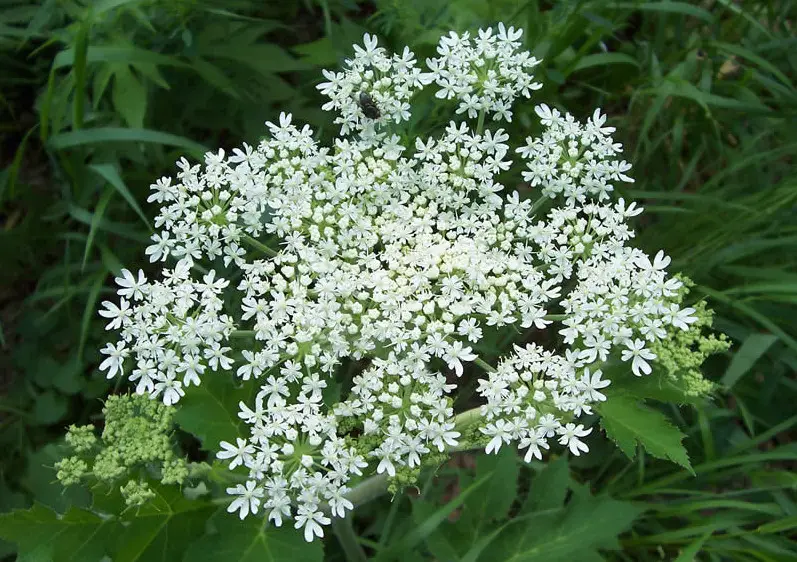
In some places, the wild carrot family member Common Cowparsnip (Heracleum maximum) is referred to as “Satan’s Celery.” Reaching over ten feet in height, with leaves that extend more than ten inches, it has tiny clusters of white flowers. Even so, it was used in traditional medicine to treat skin conditions because cooking made it safe to eat after detoxifying it.
Daisy Fleabane
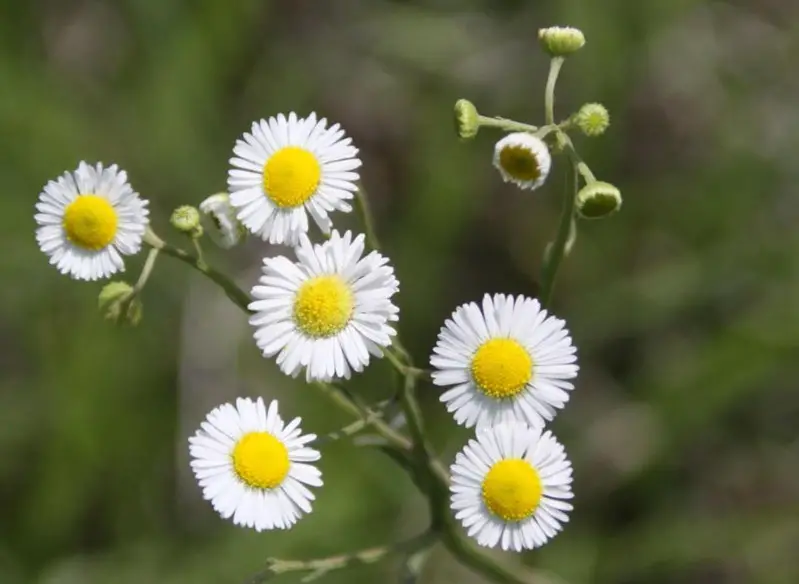
The US native daisy flossane (Erigeron strigosus) has vivid flowers with dark yellow centers and long white petals that are frequently tinged pink, scarlet, or purple. This versatile wildflower grows in a variety of soil types, including clay, and can be annual or biennial. Because of its plentiful nectar, nearby ecosystems benefit from the attraction of bees and moths.
Callery Pear
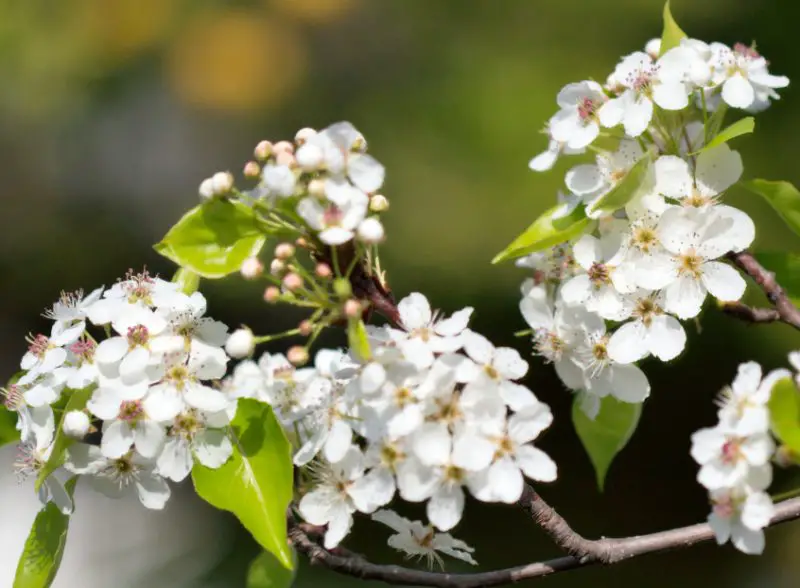
The Chinese-introduced Callery Pear (Pyrus calleryana) grows to be a towering tree that frequently reaches heights of twenty feet or more. It decorates itself with tiny, one-inch-diameter white flowers in the spring. Favored for its blooms and vivid rust-red foliage in the fall, this plant is often seen in parks and gardens.
Poison Hemlock
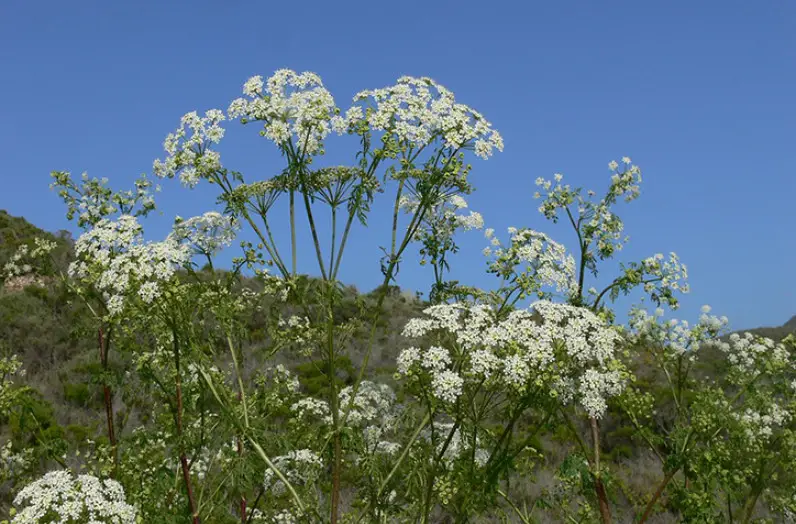
As an invasive weed, poison hemlock (Conium maculatum) presents a major problem because of its height, which frequently exceeds 8 feet and occasionally reaches 12 feet, outcompeting local vegetation. Its invasive behavior is further compounded by its prodigious growth and unusual umbrella-like clusters of small white flowers.
Thimbleberry
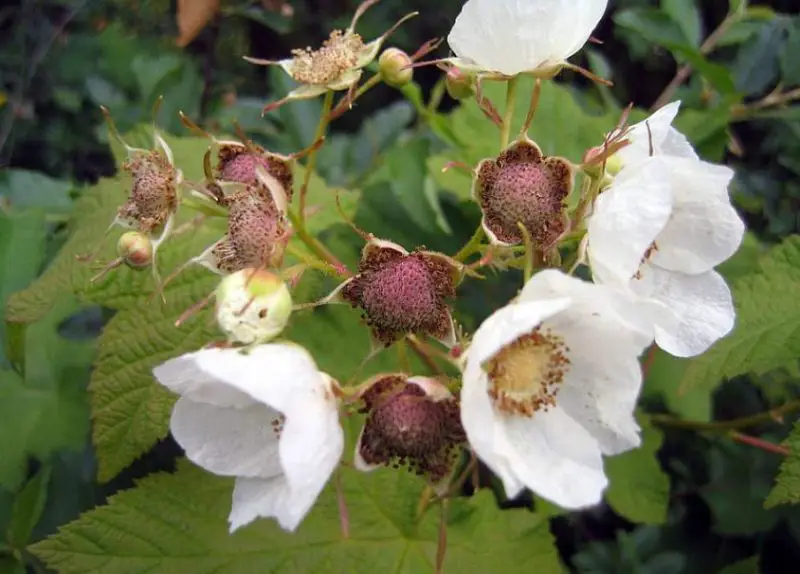
The fruit-bearing wildflower known as thymeberry (Rubus parviflorus) grows wild in the US and Canada. It produces raspberries-like fruits that have a limited shelf life, which restricts their commercial availability. Blooming plants, which are typically grown for aesthetic purposes along property borders, are adorned with huge white petals with yellow centers. At the end of summer, soft, edible fruits ripen for plucking.
White Beggarticks
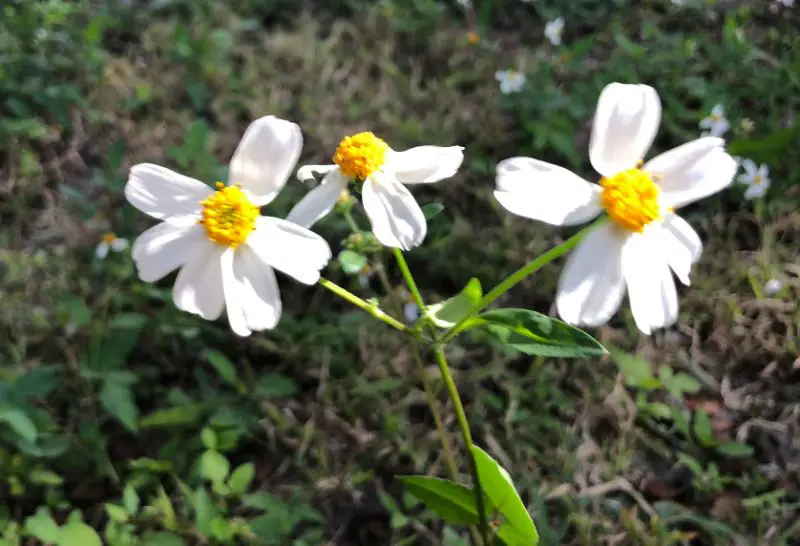
Native to North America, White Beggarticks (Bidens alba) grow especially well in Florida, where their huge white blossoms draw in a variety of species, such as butterflies, bees, and moths. Across the state, it easily spreads over dry, well-drained soils, earning it the nickname “asterweed.”
Pacific Trillium
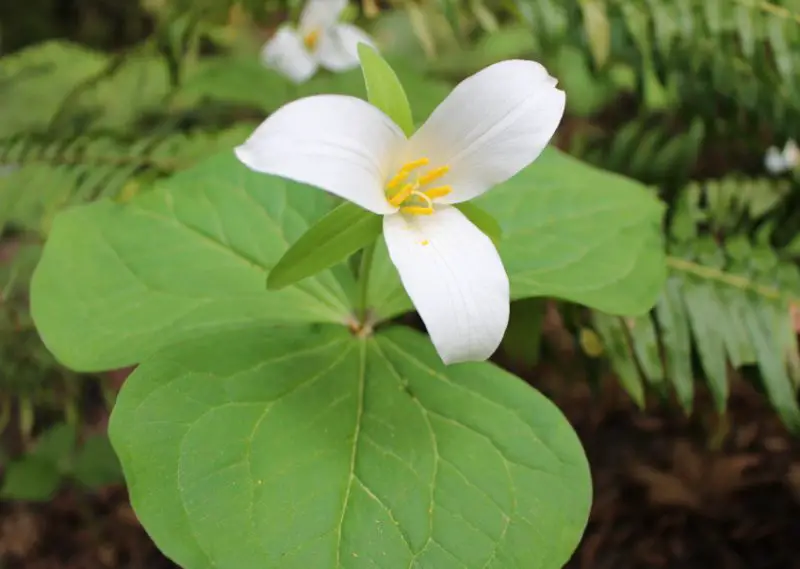
The distinctive white flowers of the Pacific Trillium (Trillium ovatum) have three long petals with pointed tips and a golden core. Its blossoms are white at first, but they might eventually turn red or violet. Even at higher elevations, they flourish in deciduous and pine-rich woodland settings, despite their diminutive size—up to 2 inches in diameter.
Dutchman’s Breeches
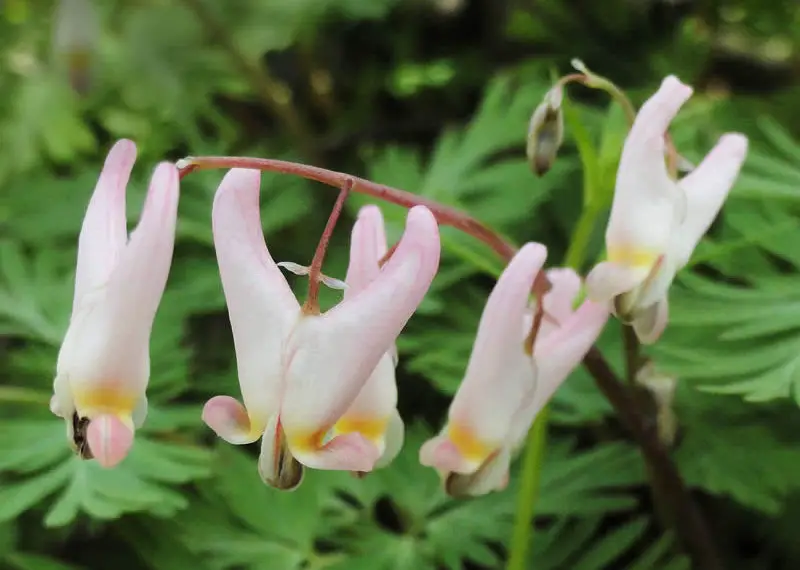
The plant known as Dutchman’s Breeches (Dicentra cucullaria) produces white blooms with an unusual form that resemble breeches and are a few inches long. Since its introduction to the US, its pink varieties—both light and dark—have grown in popularity, and its blossoms may have health advantages for the skin.
Azure Bluet
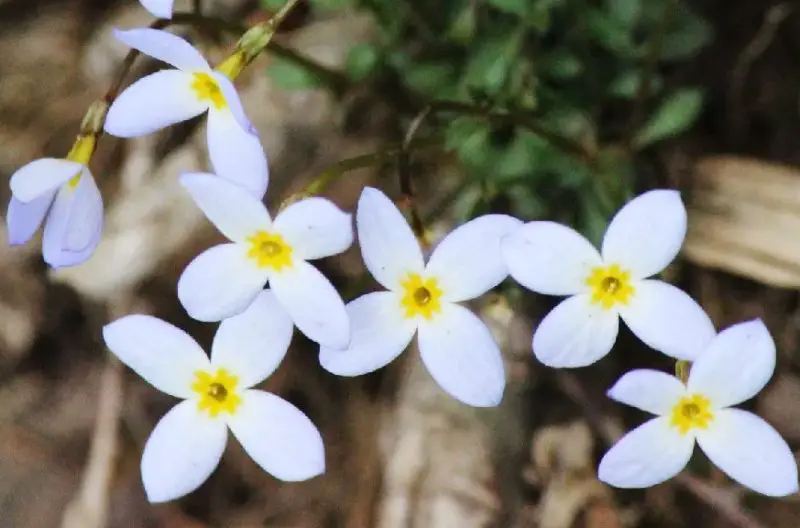
Hosta caerulea, or azure bluets, are known for their abundance of little blooms and are frequently found next to lakes and ponds. Petals are arranged in a cross shape and range in color from white to pink or purple. They are widespread in high altitudes, including prairies, and they do well in full sun, even in the mountains.
Common Star-Of-Bethlehem
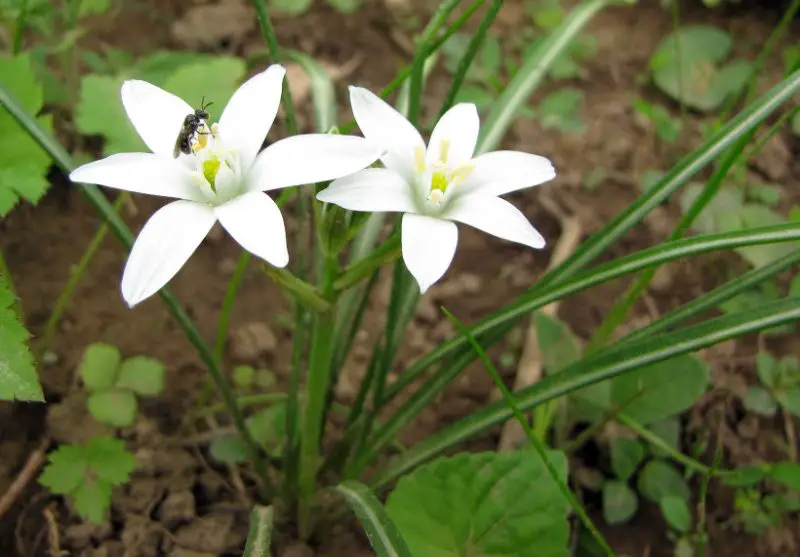
With six long, white petals, the European native Common Star-of-Bethlehem (Ornithogalum umbellatum) is an invasive plant in North America. Despite its appeal, it is extremely poisonous to people and livestock and can cause symptoms including nausea and diarrhea. It is advised to avoid touching the plant because touching it can irritate the skin.
Sacred Datura
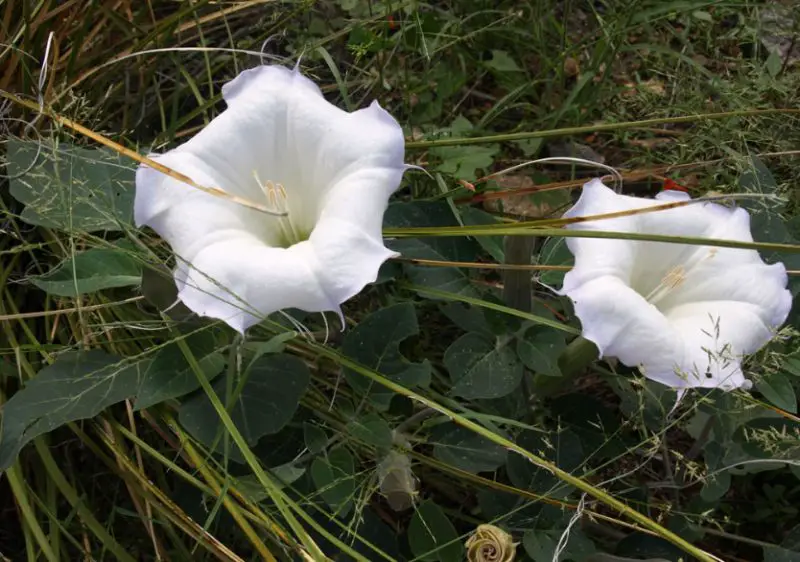
The magnificent spherical, wheel-shaped blooms of Sacred Datura (Datura wrightii) can reach up to 8 inches in diameter and have a base color of white. Pink undertones could be visible in its white petals. This species is prevalent in Southern California, where it thrives and grows tall on disturbed soils.
White Campion
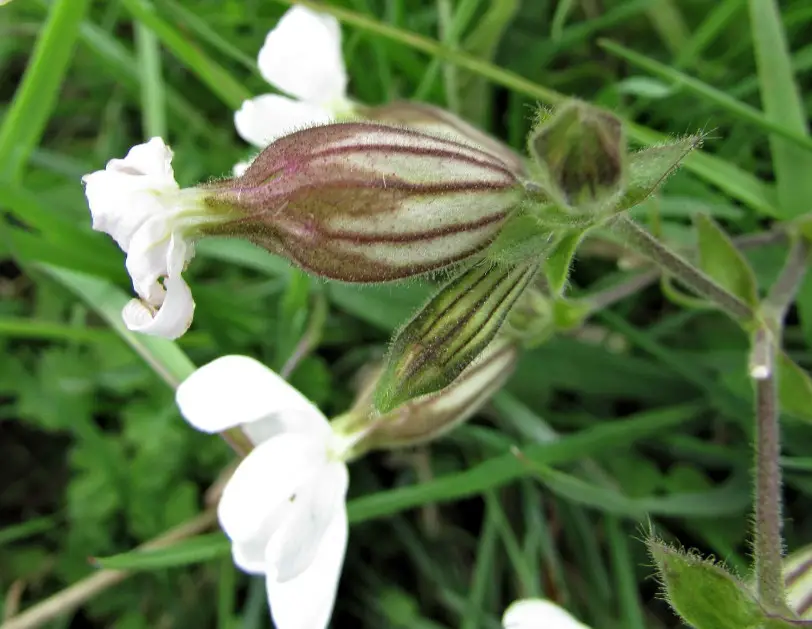
Small white blooms are the defining feature of White Campion (Silene latifolia), which is typically found in sunny garden settings and mixed forests. It grows well in many types of wet soils but is especially fond of forest gaps and margins. Growing outside of natural ecosystems requires well-drained containers.
Allegheny Blackberry
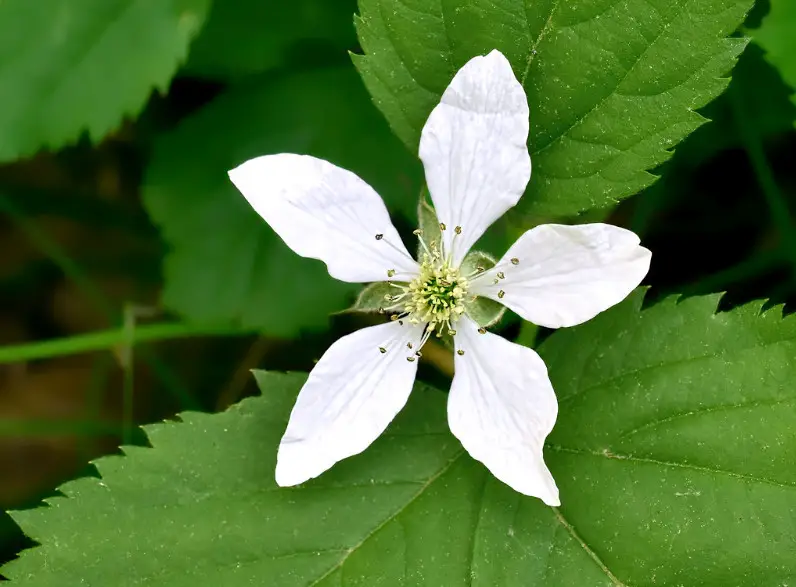
Large white flowers and then delicious fruits are produced by the Allegheny Blackberry (Rubus allegheniensis), usually starting in the second year of growth. Its widespread distribution and introduction to other US states, such as Florida, can be attributed to its eye-catching blossoms and abundant fruit production, which are favored by both wildlife and people.
Philadelphia Fleabane
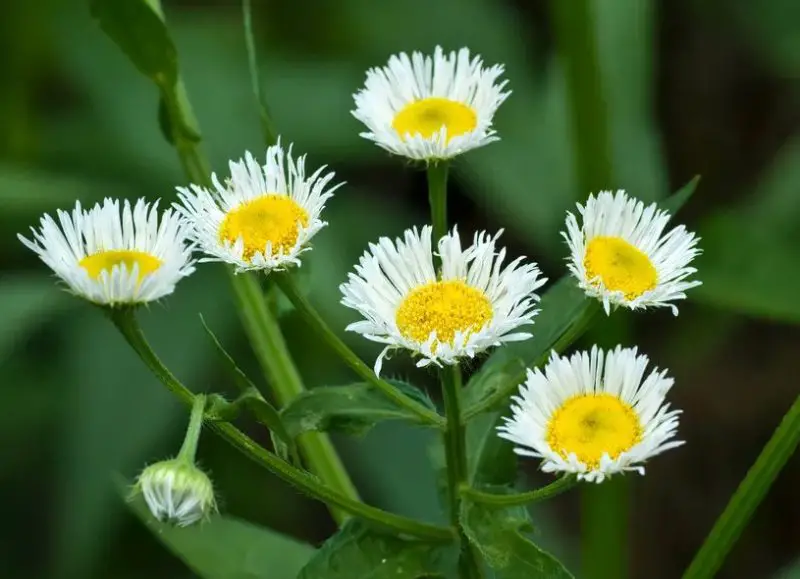
The distinctive feature of the Philadelphia Fleabane (Erigeron philadelphicus) is its profusion of white ray florets, which number at least 100 and range in color from pure white to pinkish-white. It is native to the Eastern US and grows well in a variety of environments, such as open spaces, forests, and wayside spots. It was introduced throughout the world because to its huge white blossoms, yet in many places it is still considered invasive.
Southern Dewberry
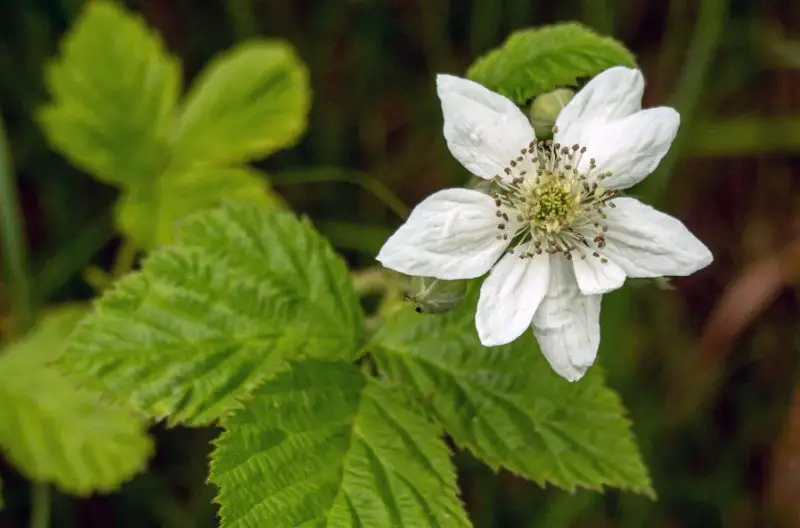
Similar to its Northern counterpart, the Southern Dewberry (Rubus trivialis) has big white blossoms. Because of its southern location, it blooms early, usually in March, with long, pure white petals. It adds a wonderful touch to the environment with its edible fruits, which can be eaten raw or baked into pies.
Northern Catalpa
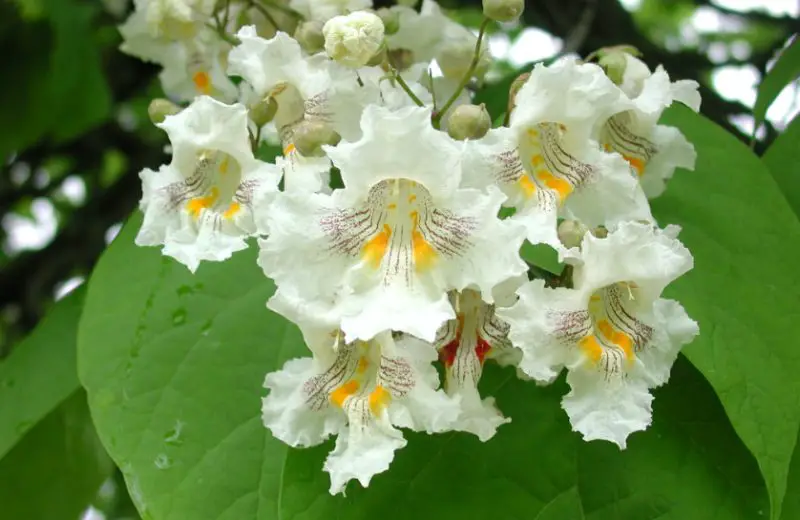
Called Catalpa speciosa, the Northern Catalpa tree grows quickly and is well-known for its bell-shaped white and yellow flowers. Its lightweight profile and soft wood allow it to reach great heights, making it perfect for wind barriers and landscapes. Despite being comparatively pest-resistant, it may draw Catalpa Moth caterpillars during bloom and produce fruits that resemble peas.
Hairy White Oldfield Aster
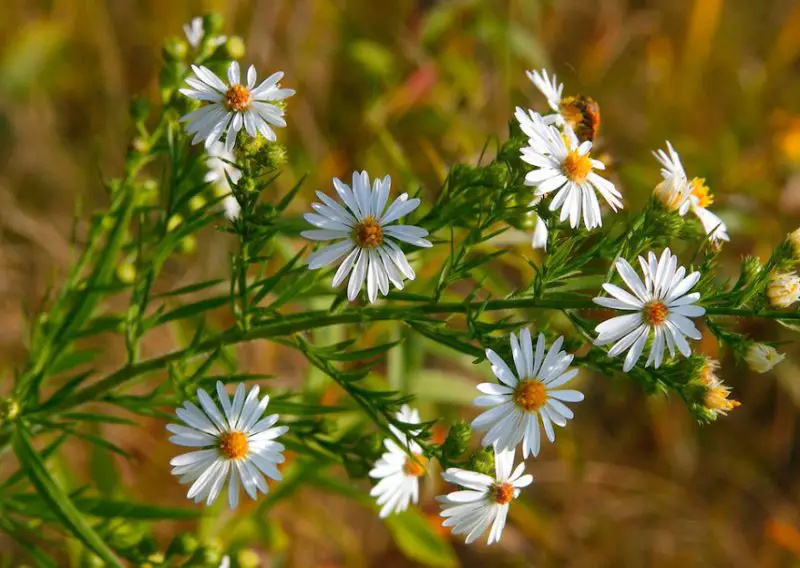
With its white flowers with dark yellow centers, the Hairy White Oldfield Aster (Symphyotrichum pilosum) is a native of Eastern Canada and the Eastern United States. It usually reaches a height of about 20 inches, although in some areas, it can grow larger, especially in woodlands and prairies. Especially, it thrives in areas that were once covered by glaciers.
Sweet Pepperbush
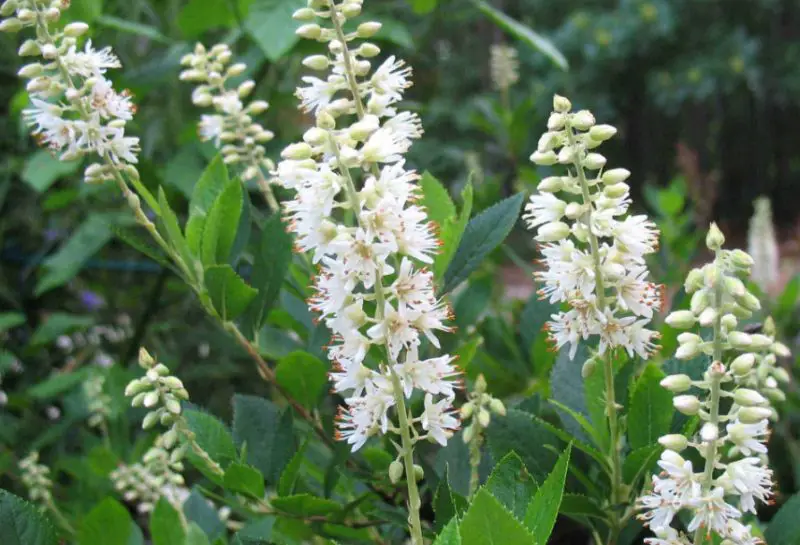
The fragrant, tiny white or pink blooms of the sweet pepperbush (Clethra alnifolia) beautify forests and damp habitats. The plant grows best in soils with a neutral pH. Its peppercorn-shaped fruits draw bumblebees, adding to its allure and significance for the environment.
Virgin’s-Bower
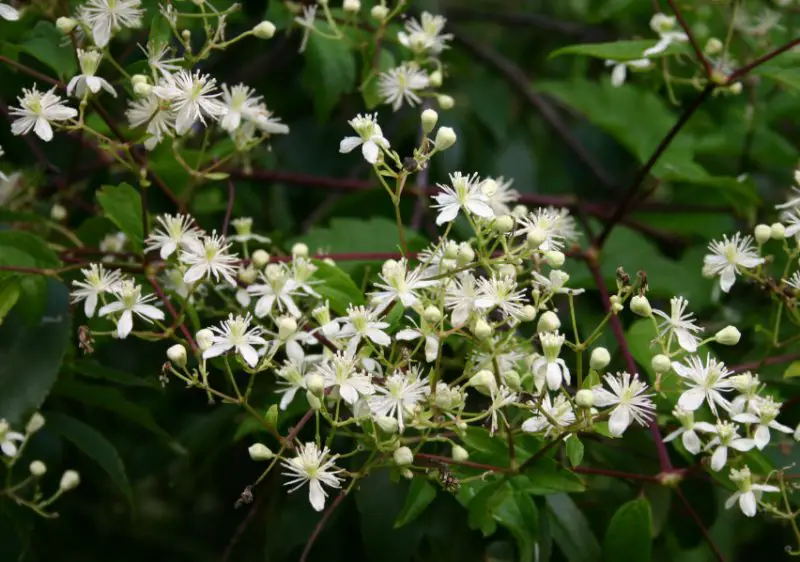
The Virgin’s-Bower, or Clematis virginiana, is a climbing plant with tiny white blooms that spreads quickly outside of its natural habitat in North America. With its profusion of blossoms, it adorns landscapes to heights of up to 20 feet.
Flowering Spurge
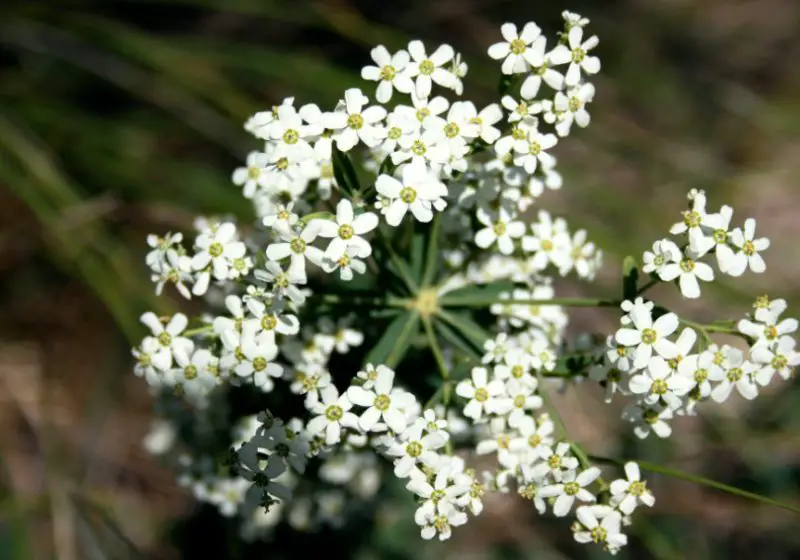
Because of its easily dispersed seeds, the North American perennial flowering spurge (Euphorbia corollata) is frequently found along wayside. It grows well in prairies, where it spreads deep roots to survive in arid soil. It has small, 0.5-inch-long leaves and tiny, white flowers that can reach a diameter of 0.25 inches.
Broadleaf Arrowhead
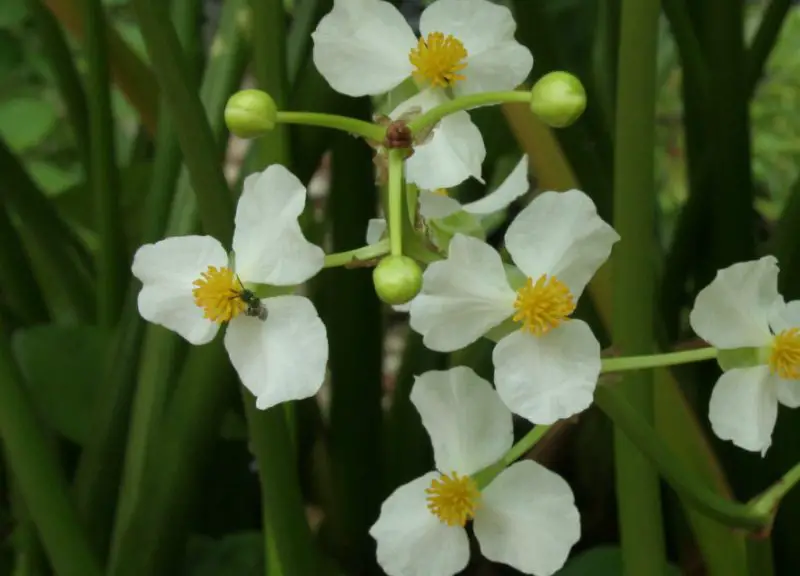
Sagittaria latifolia, often known as Duck Potato or Broadleaf Arrowhead, is a water habitat specialist that is frequently seen next to ducks. Although it grows best in still waters, it can tolerate growing in locations with mild currents and adapt to a variety of aquatic habitats.
Common Dewberry
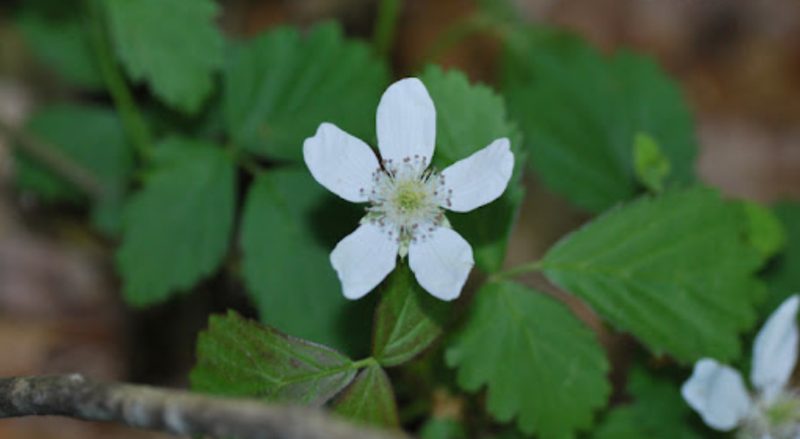
The Common Dewberry (Rubus flagellaris) has up to three-inch-long leaves and white blooms. Its tiny, one-inch-diameter flowers may grow in either full sun or partial shade and do well in dry soils. This plant yields edible fruits and is widespread in various US states, including Ohio.
White Wood Aster
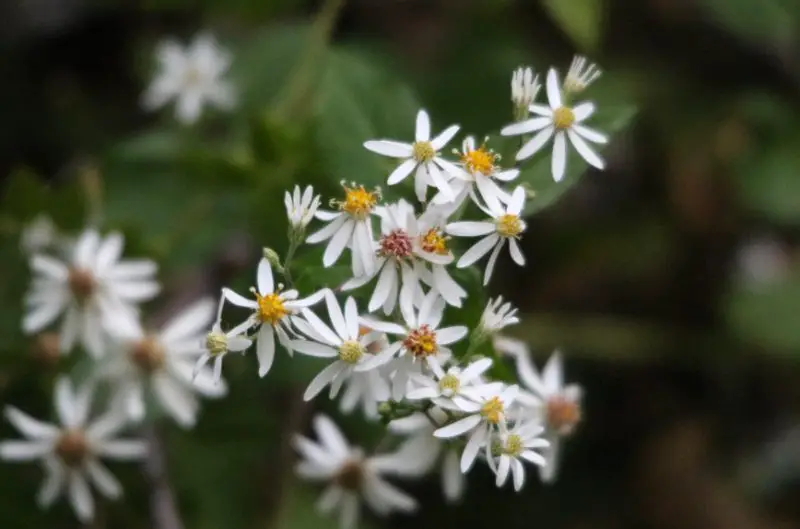
The White Wood Aster (Eurybia divaricata), which is native to Eastern North America, is prized by pollinators for its numerous white flowers with petals encircling a yellow corolla. It is a widely introduced plant that grows well in American gardens and blooms early in either full sun or moderate shade. Its beauty draws early pollinators to gardens in addition to decorating them.
Turkey Tangle Frogfruit
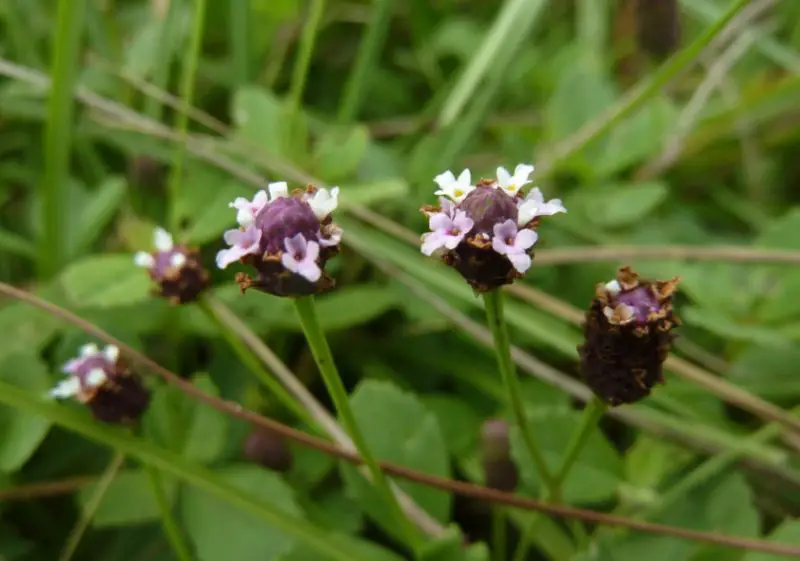
Turkey Tangle Frogfruit (Phyla nodiflora) is a plant that grows on disturbed soil and frequently invades lawns and gardens. It has many pink-tinged white blooms. Despite being regarded as invasive, it can be controlled with methods like hand pulling, which makes it a good choice for an ornamental plant or ground cover.
Black Sage
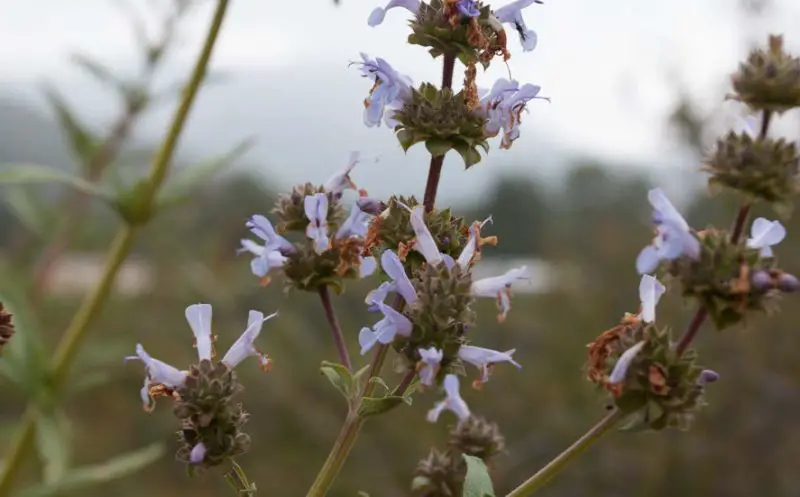
Although variations in blue and lavender are also present, white blooms are the most well-known feature of black sage (Salvia mellifera). It thrives in the rough terrain of Southern California, especially on basalt soils, and from early spring until late summer, it fills secluded places with the aroma of its fragrant blossoms.
Shepherd’s-Purse
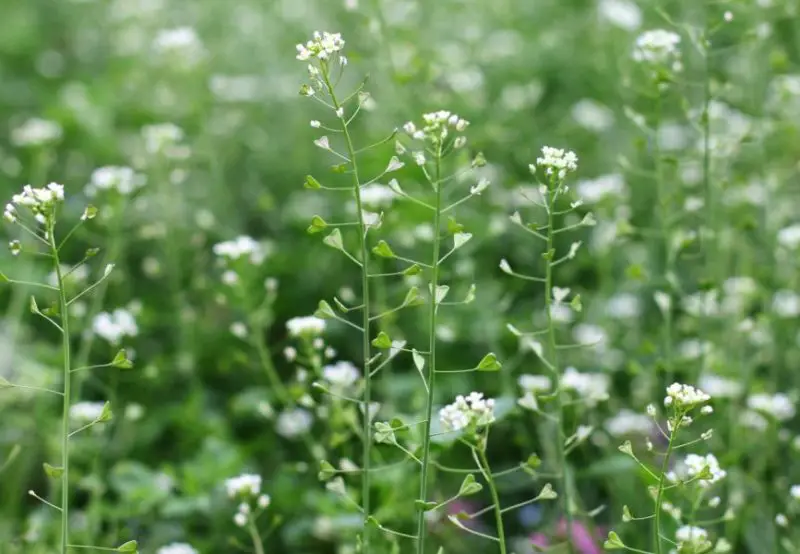
It is thought that Shepherd’s-Purse (Capsella bursa-pastoris), which originated in Great Britain, is native to Europe. In introduced regions, its tiny, 2mm white flowers grow almost year-round. Cooking it adds flavor to traditional foods even though it is considered a weed.
Crowpoison
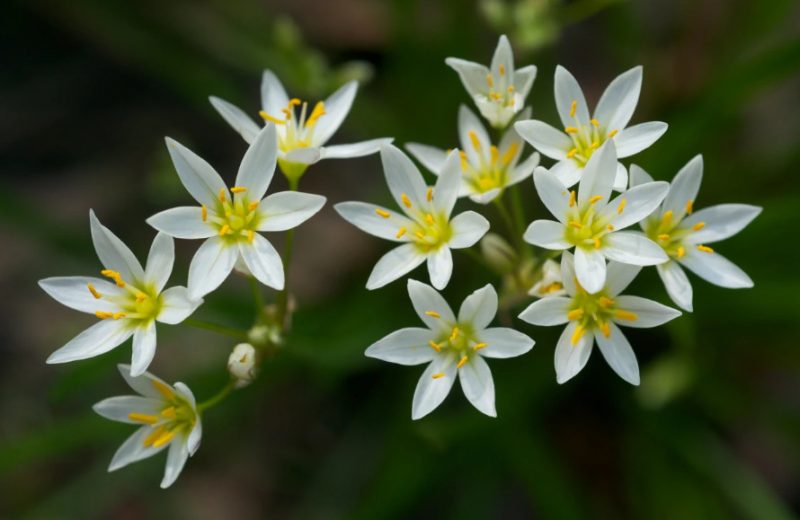
The unique white flowers of the crowdpoison plant (Nothoscordum bivalve) have green tepals striped with vivid red or orange. Each plant may have one or two stems that reach up to 12 inches, and they grow in clusters of four to six on a single stem. It is a typical sight in gardens because to its fragrance profile and numerous little white flowers, making it widespread in regions like Florida.
American White Waterlily
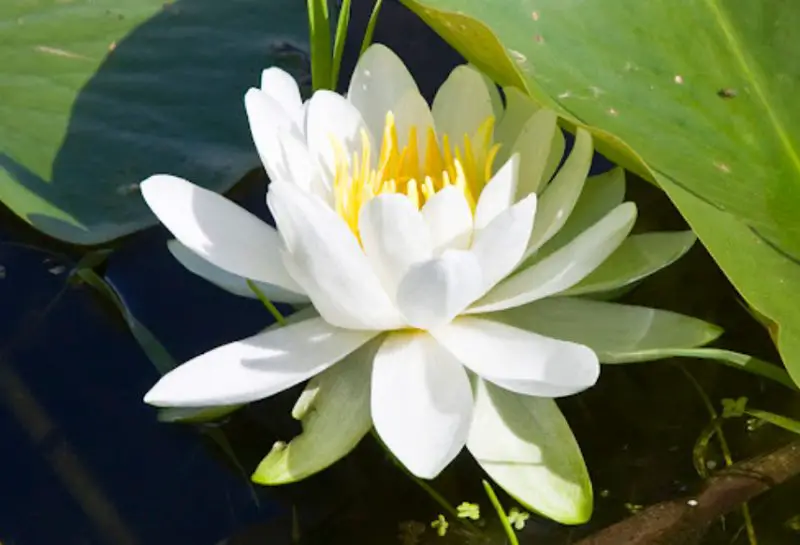
Native to North America, Nymphaea odorata, or American White Waterlily, is a species that does well in lakes and ponds. It is commonly referred to as Sweet-scented Waterlily because to its exceptionally fragrant white blooms. Its edible blooms are also used medicinally; they are boiled or fried to make drinks that treat common ailments like diarrhea.
Star-Flowered Lily-Of-The-Valley
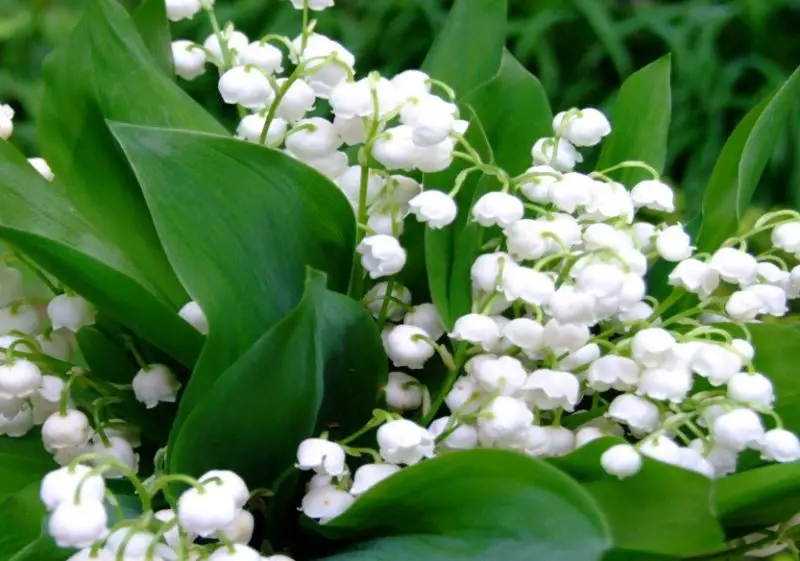
Prairies and mixed woodlands are two of the many environments that the star-flowered lily-of-the-valley (Maianthemum stellatum) loves. Called for its star-shaped blooms, this perennial grows up to 4–5 inches tall and is common in coastal areas of California.
Southern Magnolia
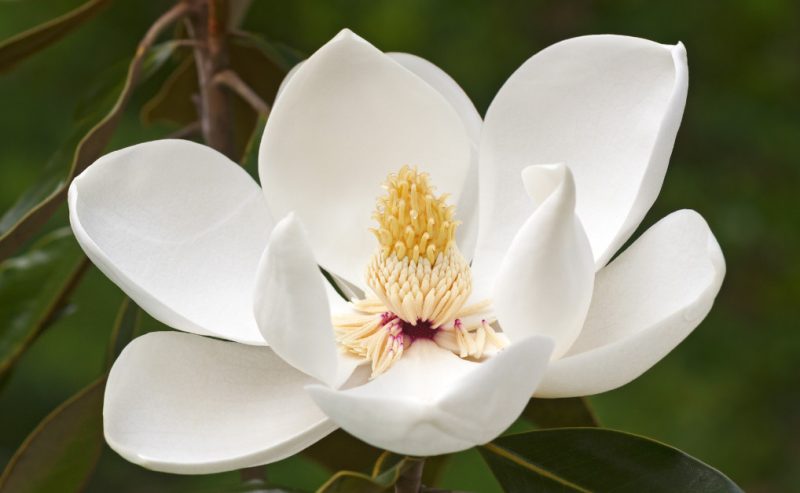
Magnolia grandiflora, commonly known as the Southern Magnolia, is a striking plant with enormous white to yellow flowers that can grow up to 12 inches in diameter. With a height of up to ninety feet, this tree has a lengthy lifespan and begins to yield seeds after ten or more years. Originating from environments near the Gulf of Mexico, it is particularly widespread in South Carolina and Florida. Its huge petals and seeds attract wildlife like as squirrels, and its numerous cultivars make it a popular choice for gardens around the country.
Common Boneset
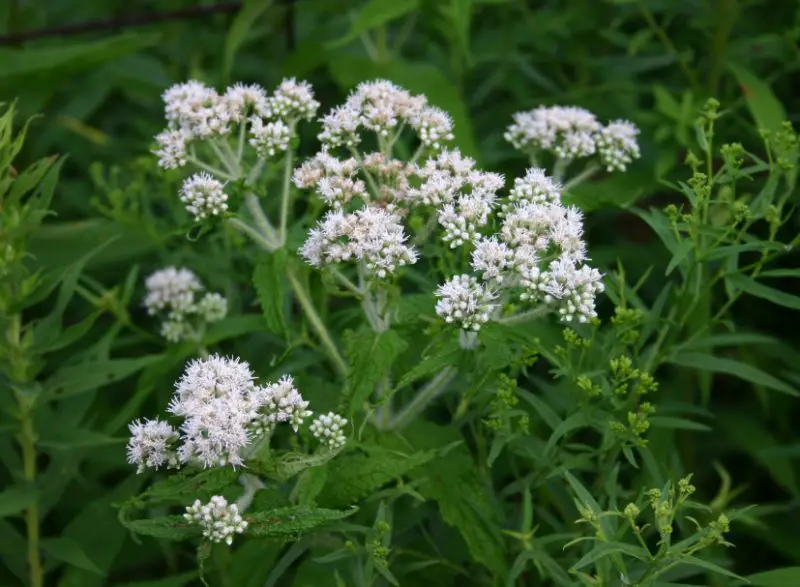
From the Gulf of Mexico to Canada, the Common Boneset (Eupatorium perfoliatum) is known for its tiny white blooms that bloom in clusters. Growing wild in prairies, wooded areas, and wet environments, it has long been used medicinally to treat conditions such as excessive perspiration, which has earned it the moniker “The Sweating Plant.”
Northern Starflower
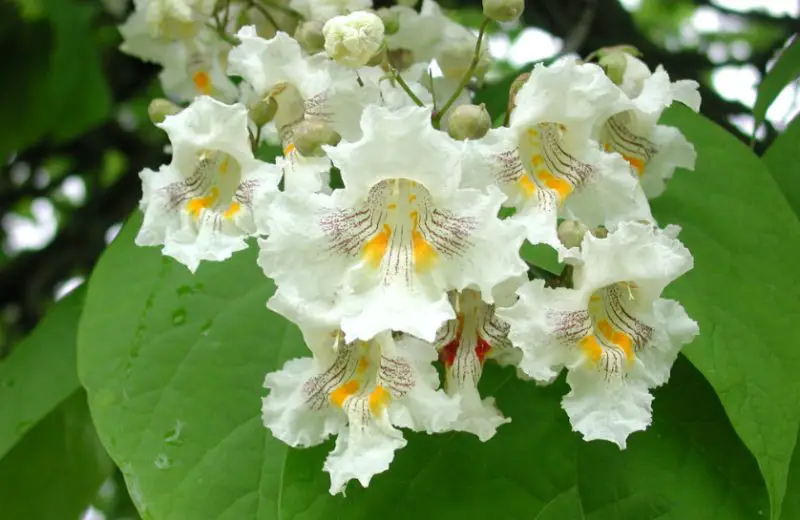
Once common throughout the US, the Northern Starflower (Lysimachia borealis) is now threatened in several states. It is up to 8 inches tall, with tiny upward-facing white flowers and broad leaves that bloom in late spring or early summer. Its spherical, tiny flowers stand out among the white petals.
Annual Fleabane
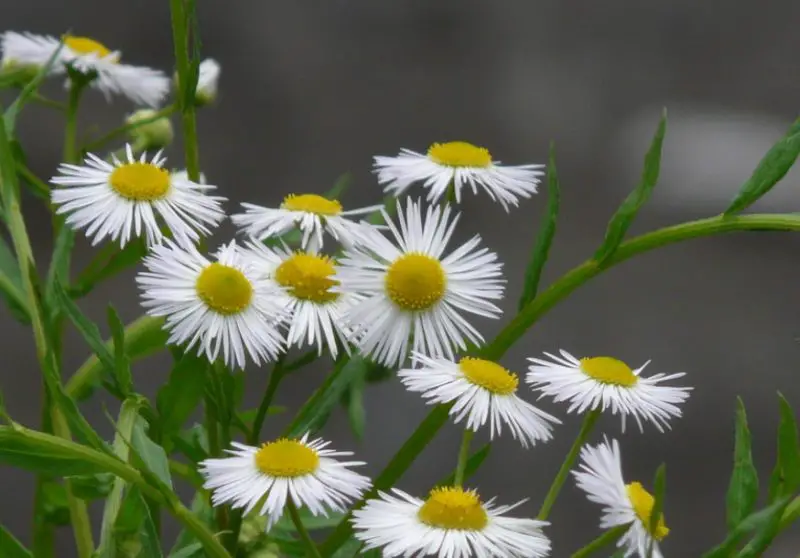
Annual Fleabane (Erigeron annuus) distinguishes itself with its towering height, reaching several feet, unlike the short Northern Starflower. Adorned with multiple white flowers, its thread-like petals encircle a striking yellow center, attracting pollinators across North America. While prevalent in the Eastern US, it also appears, albeit less abundantly, along the West Coast.
Common Hedge Parsley
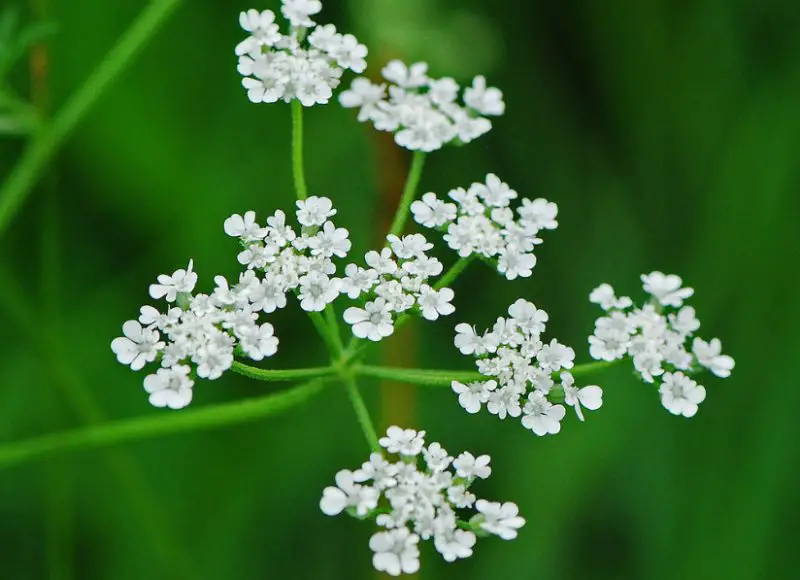
Small white flowers adorn the Common Hedge Parsley (Torilis arvensis), an alien species brought to North America, which is similar to Common Parsley. This hairy herb spreads its seeds widely because of its spiny stems, which easily cling to clothing and animals. Since it’s an annual, it can be recognized even when it’s not in bloom.
Carolina Crane’s-Bill
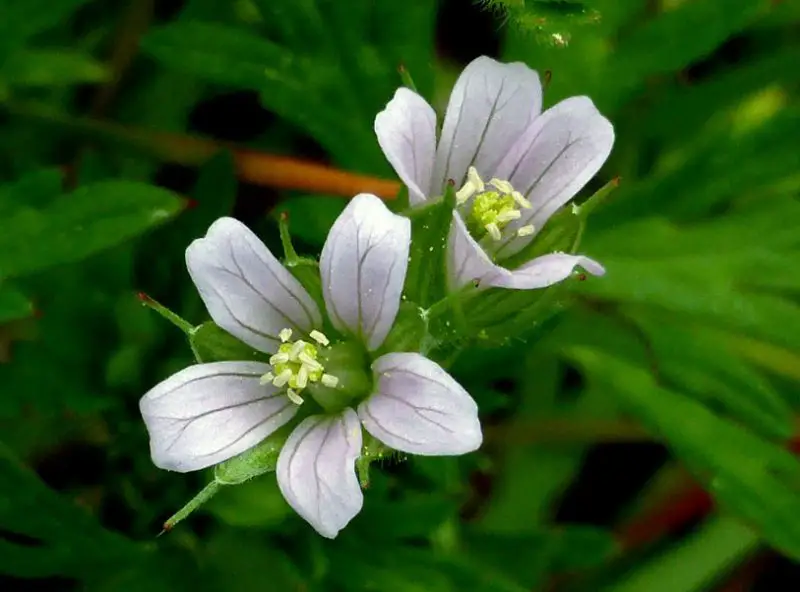
Small white flowers blooming in summer, the Carolina Crane’s-Bill (Geranium carolinianum) is a member of the geranium family that grows abundantly throughout the Southern United States. They also have pink, purple, or red blossoms and can grow up to a foot a year. Their abundance in nectar draws a variety of animals, although their status varies depending on the area; in certain cases, they can even become invasive in particular environments.
Hedge Bindweed
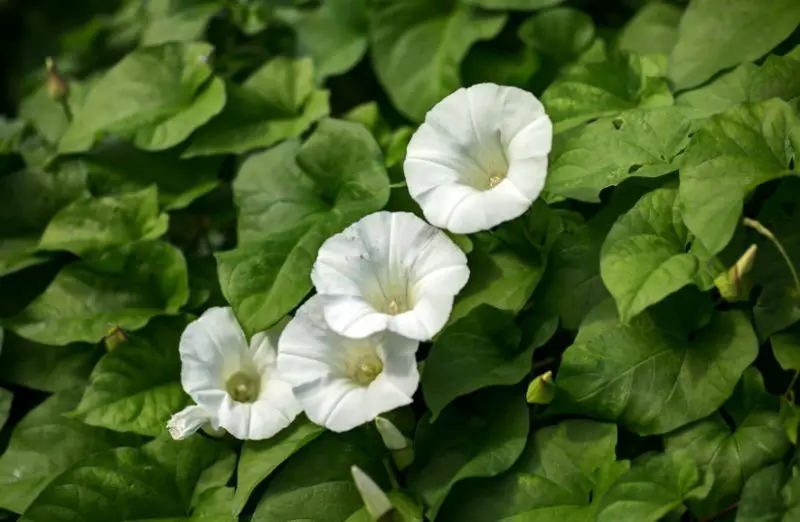
The huge white flowers of hedge bindweed (Calystegia sepium) range in color from white to pink or white to yellow. It grows like a weed when it is a vine, competing with nearby vegetation like trees for resources and pushing out native plants in the process. Some specimens are over ten feet tall and dangerous to the plants they climb.
Common Yarrow
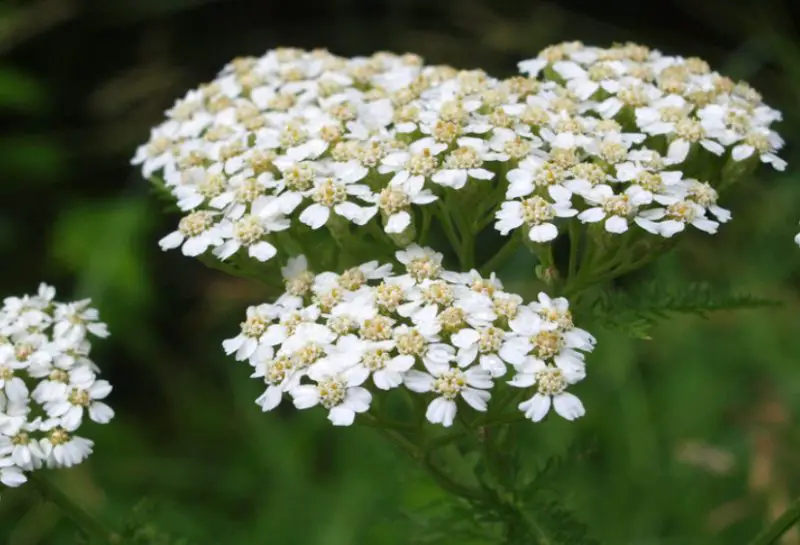
The common yarrow, or Achillea millefolium, is a common white flower found in Europe, Asia, and North America. It can be white, cream, or even crimson or pink in color. It grows well in a variety of settings, including high alpine regions and lowlands.
White Clover

Trifolium repens, also known as white clover, is a temperate-zone plant that grows well alongside crops. Its capacity to fix nitrogen in soil makes it valuable. Its white blossoms decorate disturbed regions, while it is primarily used as cattle fodder.
White Snakeroot
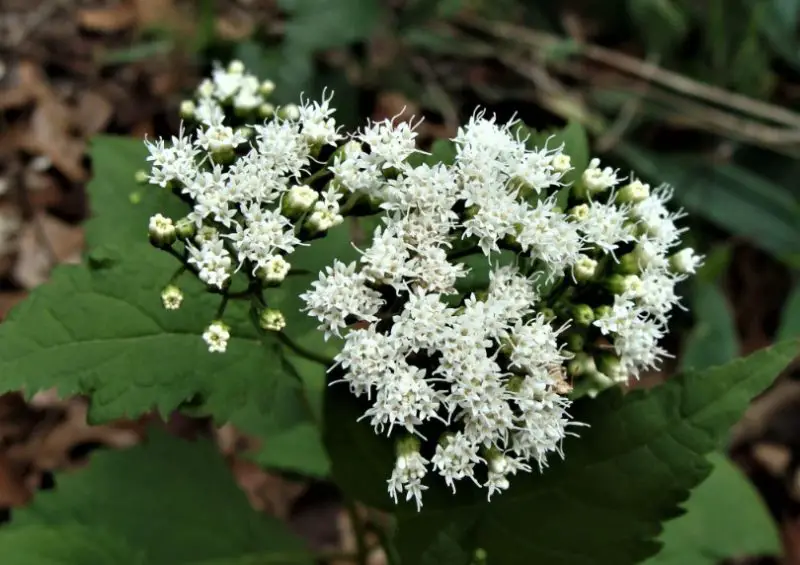
Native to the Central and Eastern United States, white snakeroot (Ageratina altissima) grows up to five feet long stems bearing tiny white flower heads. It is poisonous, especially to cows, and can taint milk, which can then damage humans.
Garlic Mustard
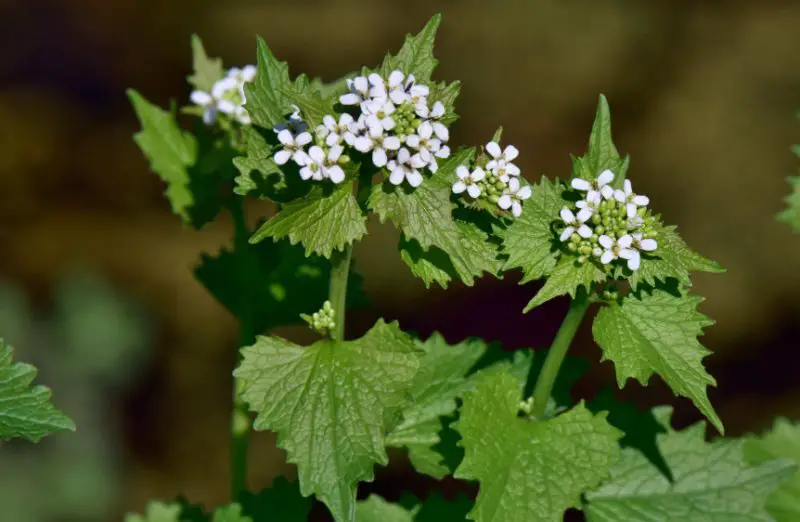
Little, triangular petals adorn the white blossoms of the common wildflower garlic mustard (Alliaria petiolata). Despite being widely distributed, this imported species—which blooms in the spring in North America—was originally employed for soil stability.
Wild Carrot
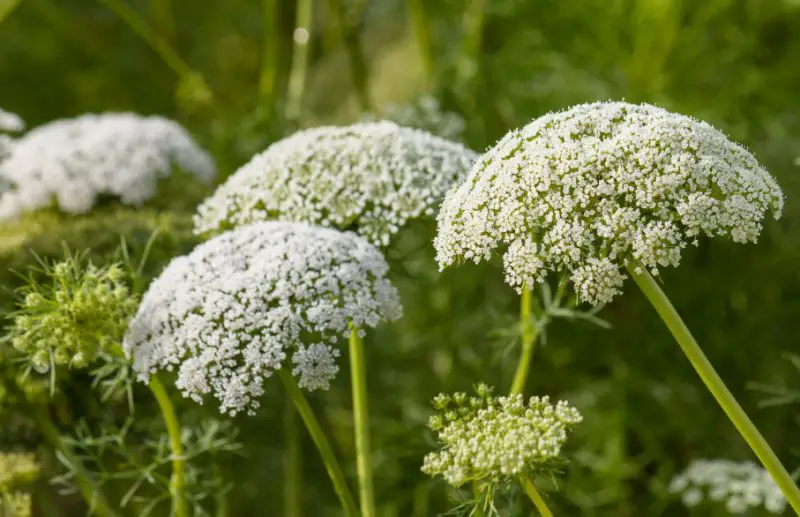
The white flowers of the wild carrot (Daucus carota) are clustered in umbels, clusters that can grow up to 6 inches in diameter. Crops benefit from the pollinator and predatory wasps that are drawn to these upward-facing umbels. They were brought to North America and are good to agricultural habitats.
Multiflora Rose
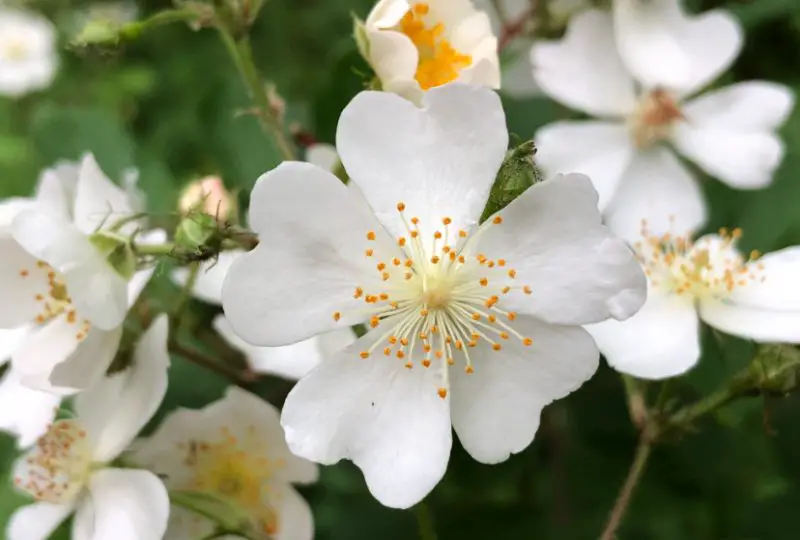
Similar to wild carrots, multiflora roses (Rosa multiflora) have white blossoms that occasionally have pink undertones. It was first imported for decorative and soil stability purposes, but it has now grown quite invasive. On the other hand, goats like it as fodder.
Bloodroot
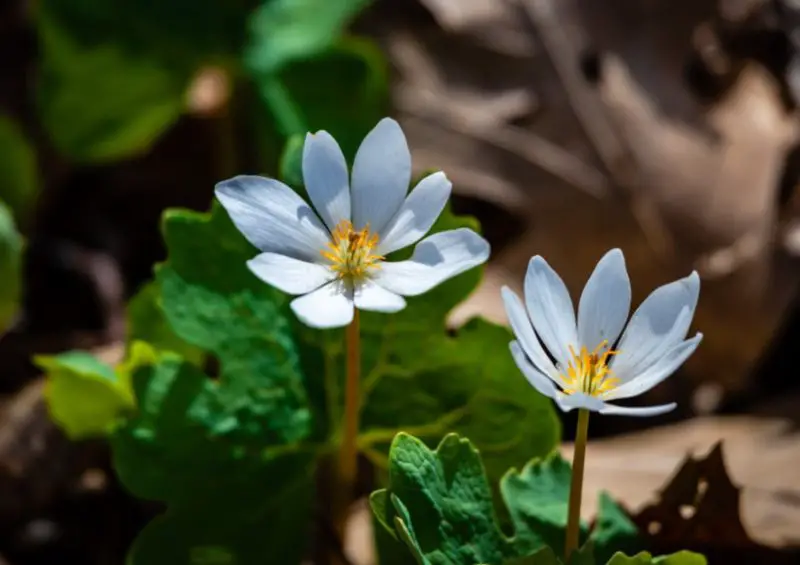
Known for its scarlet sap, bloodroot (Sanguinaria canadensis) has big, white blooms with long petals. From the Great Lakes to Florida, it’s beloved throughout the spring and summer months despite being poisonous.
Striped Wintergreen
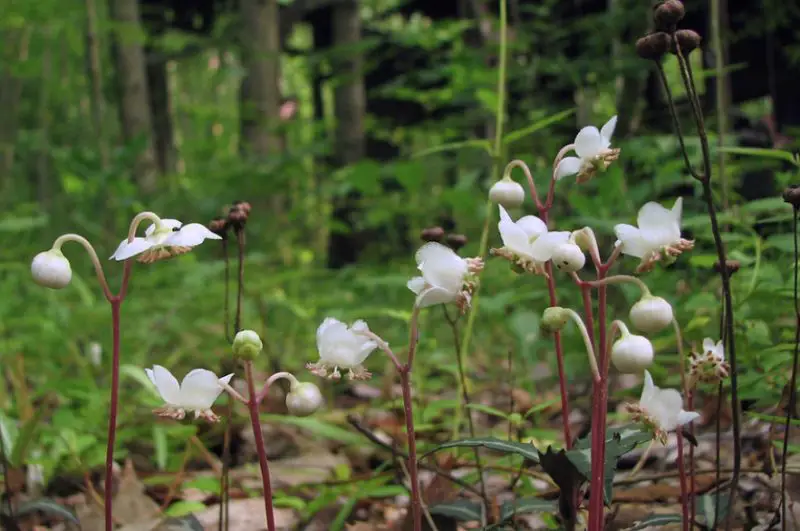
With its characteristic white blossoms, Striped Wintergreen (Chimaphila maculata) is a plant that is extensively dispersed throughout North America, ranging from Canada to Florida. It prefers forests and clearings for its late summer blooms, which can reach up to 10 inches in height.
Black Locust
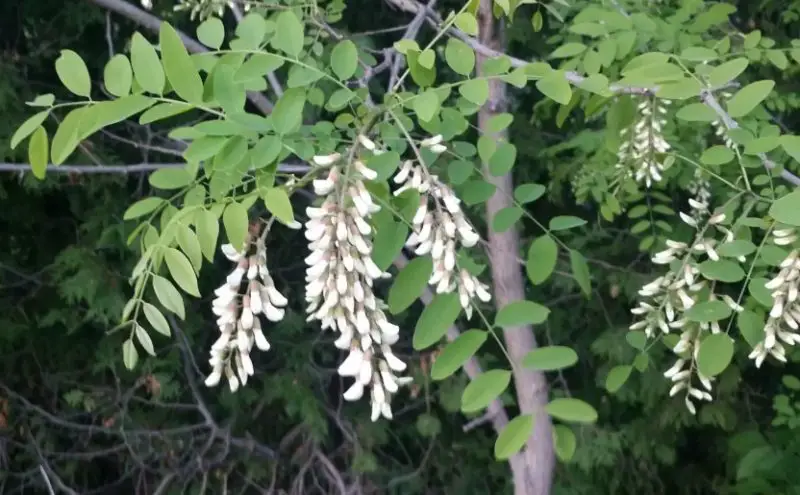
Native to North America, the black locust (Robinia pseudoacacia) has pure white blooms. Clustered in groups of up to nine, each 1-inch flower has a limited life, usually a week or so. Its short bloom time draws pollinators because of its pistils and stamens, which facilitates reproduction. Among the white wildflowers, Black Locust is distinguished by its powerful perfume.
Flowering Dogwood
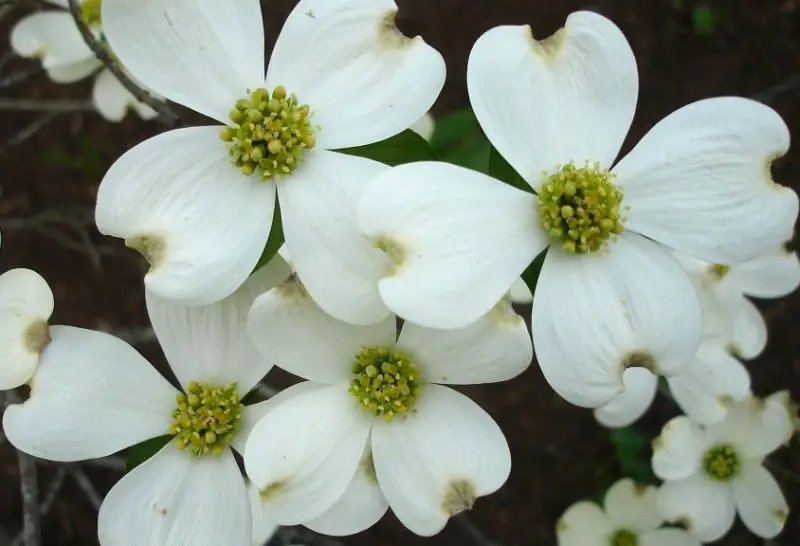
The gorgeous yellow flower heads of Flowering Dogwood (Cornus florida), sometimes referred to as White Dogwood, are encased in four to six enormous white petals. Because of its unique bark and eye-catching blossoms, it’s a well-liked tree for parks and gardens. Originating in Eastern North America, its self-propagation quality adds to its attraction.
Mountain Laurel
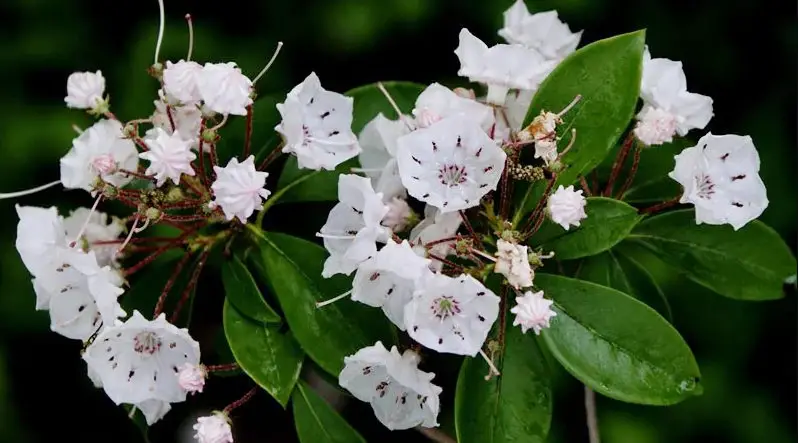
The umbrella-shaped, enormous white blossoms of the mountain laurel (Kalmia latifolia) are often tinged pink. Its poisonous nature and large size render it unsuited for gardening, even with its breathtaking May blossoms. Because of its extensive roots, removal is difficult.
Milkmaids
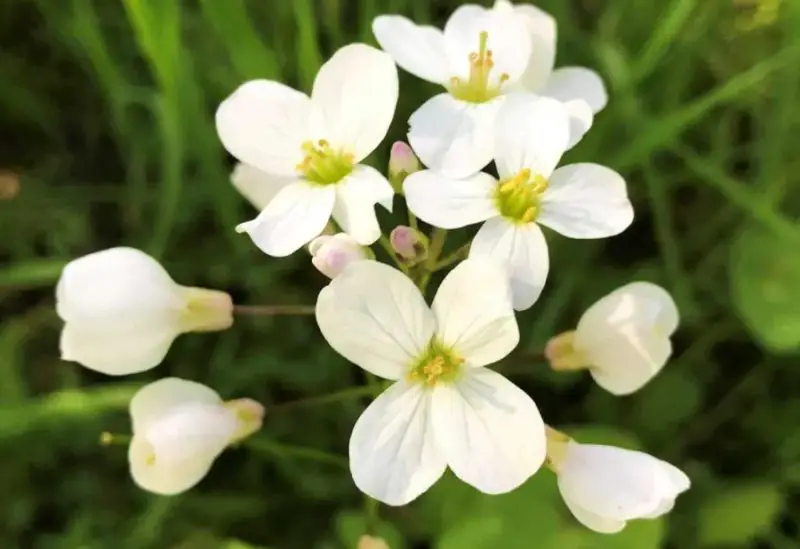
The southern sections of California are home to Milkmaids (Cardamine californica), a native plant of North America, which bloom early in the spring and produce white or white-pink flowers that remain until May. They usually don’t get much taller than a foot and love full sun, especially in the afternoon.
Calico Aster
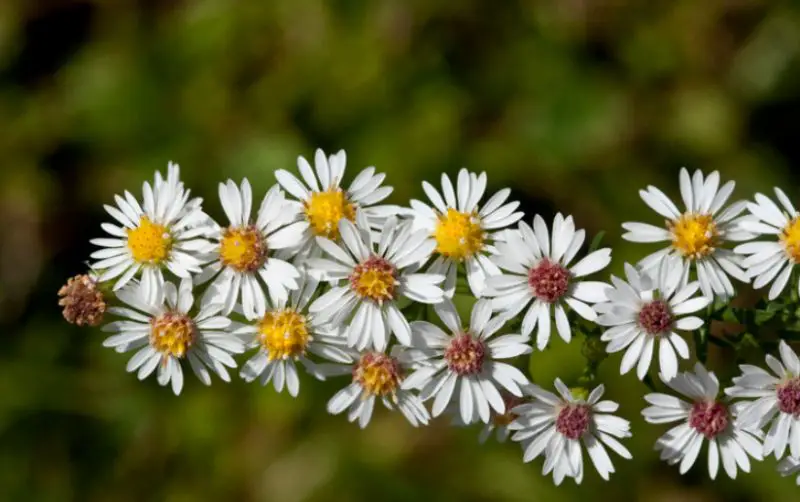
The flowers of the calico asters (Symphyotrichum lateriflorum) are primarily white, though they can also be pink or violet in color. They are important providers of pollen for bees and other insects, with their characteristic white petals and yellow center part. Hoverflies and sweat bees are drawn to these adaptable wildflowers, which set them apart from other aster species by changing the shape of their leaves to fit their surroundings.
Lawn Daisy
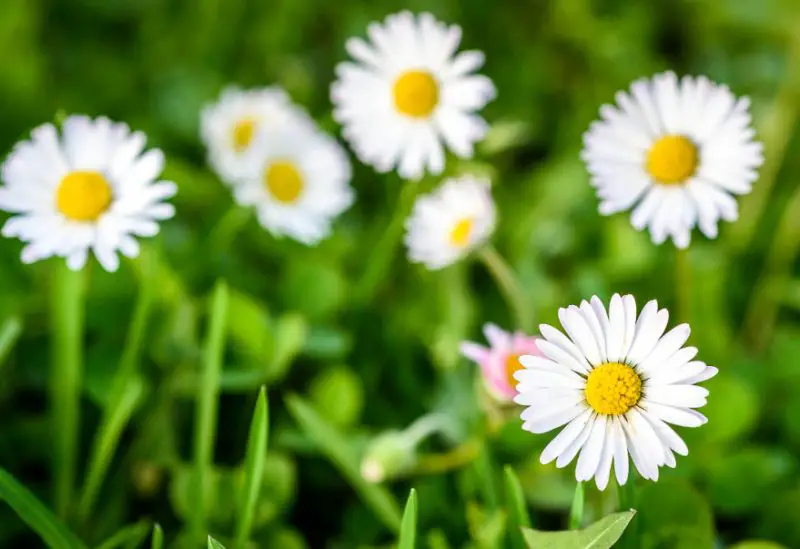
With its white and yellow blossoms, the noxious weed known as Lawn Daisy (Bellis perennis) spreads and overtakes lawns. It grows back if left unchecked; its height varies by area but usually reaches up to 8 inches. It is resilient and adaptive. It can spread throughout parks and meadows due to its lengthy blossoming season; it can even bloom in the winter.
Foxglove Beardtongue
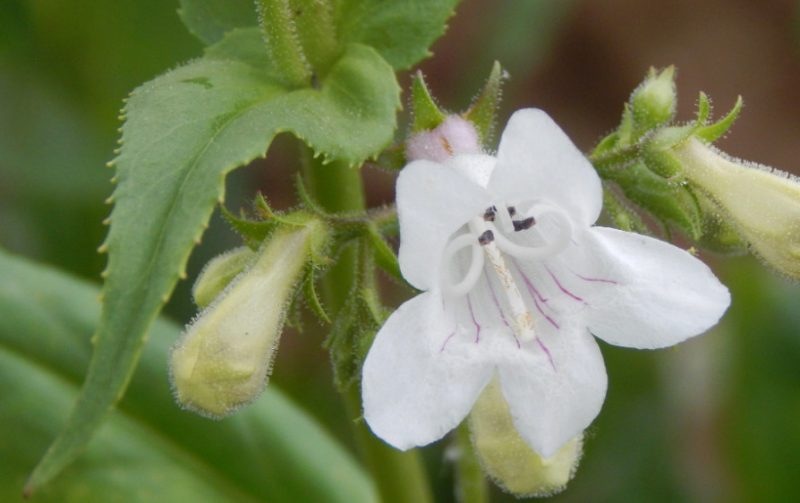
Penstemon digitalis, often known as foxglove beardtongue, grows tall, erect stems that hold several feet of small white blooms. It is a popular cultivar that is widely distributed throughout the Western US; hybrids of different hues, such as pink, are more frequently found in gardens.

